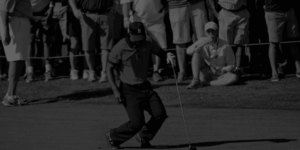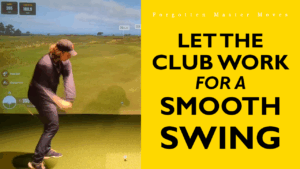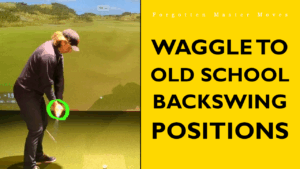
Harvey Penick Magic Move – In Different Variations
The original Harvey Penick Magic Move refers to a simple gravitational drop of the arms toward your pocket, combined with a lateral slide.
However, over the years, it has evolved—at least in my understanding.
Let’s break it down and see what we find.
Harvey Penick Magic Move – In Its Simplicity
It’s essentially a gravitational drop from the top of your backswing down toward your right pocket. This movement shallows both the hands and the club while you slide toward the target.
The guys from Athletic Motion Golf break it down around the three-minute mark in this video:
This was the standard instruction back in the day when the swing arc was the engine of the motion, making it a perfect fit. Players like Ernie Els describe this as their downswing trigger, and Ben Crenshaw was also a strong advocate of it.
Now, let’s explore what happens when you take it even further…
Semi Pushed – Promoting Target Orientation or Forearm Rotation
Most golfers who perform a semi-pushed version of the magic move tend to rotate their humerus bone externally in the shoulder socket, which effectively opens the clubface.
This is often paired with excessive right-side lean (or secondary axis tilt), which forces the hands to push forward in an attempt to bottom out the club too soon.
At this point, you have two choices: either you hit the ball fat due to excessive shallowness, or you find a way to compensate.
A common fix is to aggressively extend the low point by pushing the hands toward the target. This works because the hand push steepens the motion, counteracting the overly shallow position.
A less common but, in my opinion, even more effective solution is to use the forearms to manage the excessively open clubface while harnessing the centripetal force of a low-and-left move. This pulls the arms more over the body while allowing the club to descend naturally through centrifugal force—a core principle of advanced ball striking.
Big Push – Sling Shot Power System Unlocked
If you take the Magic Move position and push the arms over the body to induce shaft lean, you’re stepping into the realm of the modern baseball-style golf swing seen in some tour players. This move typically isn’t paired with the traditional Magic Move slide but is executed in a more centered motion.
It’s actually so distinct from a “normal swinging motion” that it operates on an entirely different power system—more of a sling than a swing or a hit.
Players like Viktor Hovland, Joaquin Niemann, Collin Morikawa, and Dustin Johnson are prime examples of this style in action.
Back to the Original Harvey Penick Magic Move – Intentional or Just Happening?
Do you need to train it, or does it just happen?
I actually perform what looks like a Magic Move, but it’s simply the result of using the swing arc correctly—with the intention of applying speed early in the arc and then letting go of grip pressure. This allows gravity to naturally create the Magic Move effect.
For a while, I worked on the pump drill taught by instructors like Pete Cowen, which is essentially Harvey Penick’s Magic Move on steroids. But it wasn’t for me—it took up so much mental space that it dominated my entire swing feel.
My solution in the FMM Swing, and the approach of many old-timers, was to use the downswing arc with clear intention. This naturally produces the same positions the Magic Move is designed to achieve.
I prefer it to happen on its own, but I also see the value in training it—especially if you’re comfortable with swing thoughts during the transition.
In the end, it’s really just a matter of personal preference.
Swing Knowledge and Flaws Articles

Bad Back from Golf – Lower Back Pain and Pelvic Issues
Suffering from a bad back from golf has been a major driving force behind my ten-year study of the golf…

A Shallow Golf Swing – Which Move Creates the Magic?
How is it that many tour pros don’t visibly shallow their golf club early in the downswing, yet still deliver…

Why You Slice – The Fundamental Reason Behind It
If you google why you slice the the first article (check it out here) will list ten reasons that are…
Major Swing Change Article Series

Basic Swing Change Tips: Small Advice with Big Potential
Making a swing change can be challenging and requires more than most golfers realize. To successfully change any part of your swing, you typically need between 3,000 to 5,000 repetitions (based on my experience)….

Asking Successful Swing Change Questions – Where to Go?
You’ve probably figured out by now that I’m not someone who promotes “quick fixes.” Instead, I focus on the deeper foundations of swing change efforts. In all honesty, there’s no other way to make…

Simplified Swing Change Plan – PDF Download
Use this entire website to fill out the blank spots in the Simplified Swing Change Plan. The plan itself is a very simple resource that you download, print and then adapt to your own…
Some General Swing Tech Posts (with Videos)

Let the Club do the Work! How to accomplish Smoothness
Let the Club do the Work! How to accomplish Smoothness I teach a motion where the golf club does the work for you. Where you don’t need to hit the gym every other day,…

Flipping in Golf – Good or Bad? It Depends
Flipping in Golf – A Misunderstanding? There are many ways to execute a golf swing. In the old-school style, where the swing arc drives the motion, allowing the club to overtake the hands, aka…

Using the Waggle in Golf? A training for Backswing Mechanics
Using the Waggle in Golf? A Training for Backswing Mechanics There’s a direct link between how you perform the backswing and how well you can let the club work for you. If you waggle…
The FMM Swing Articles

Swing Intentions – The Missing Piece for Great Golf?
Ever thought that what professionals (or the awesome players at your club) are doing isn’t quite the same as what you’re doing? Ever wondered if you can accurately draw conclusions about someone’s swing by…

Swing Thoughts Deep Dive: Should You Think in Golf?
You should never play “a mind full of mechanics golf swing” on a round of golf. I agree with that, but at the same time it’s hard not to think at all. For me,…

A Transition Free Golf Swing – Is this Possible?
The transition part of the golf swing can be tough to master since it happens relatively quickly and it has such big effects on your striking. To answer the question directly: No, you need…